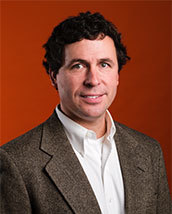Clearpath Robotics adds Tesla cofounder to advisory board
Clearpath Robotics Inc., which is developing self-driving vehicles for industrial use, said today it has added Marc Tarpenning, the cofounder of Tesla Motors Inc., to its advisory board.
Tarpenning has extensive experience in running startups, deep knowledge of mobile technology, and an understanding of engineering challenges, Mike Hanuschik, Clearpath's chief product officer, said in an interview yesterday. Along with Elon Musk and several other partners, Tarpenning in 2003 cofounded Tesla, which revolutionized automotive manufacturing by developing the first mass-production cars to be powered by lithium-ion battery cells. Tarpenning cofounded e-book manufacturer NuvoMedia in 1998. "Self-driving technology is clearly on the cusp of a major breakthrough," Tarpenning said in a statement. "I'm happy to offer my assistance to Clearpath who, much like Tesla, has ambitious goals for making a meaningful impact on society." Tarpenning was unavailable for an interview. Clearpath is already shipping self-driving vehicles for indoor applications, such as its Otto platform for warehouse and material handling use. Designed to operate in cooperative swarms, each pallet-shaped Otto robot can transport loads of up to 3,300 pounds at speeds up to 4.5 mph, using laser sensing to navigate around industrial environments.
"What we're doing is essentially running a miniature, self-driving automotive company, so Tesla's technology is definitely related," Hanuschik said. Tesla uses an array of assisted-driving technologies in its vehicles, such as lane-following guides and lane-changing alarms. Clearpath's robotic vehicles are fully autonomous mobile platforms, although they operate only in controlled indoor environments.
The specter of automated cars and trucks cruising the nation's highways is still five to 10 years away, Hanuschik said. But the technology is developing quickly as customers find new applications for indoor robotic platforms, he added.
"Within the next 10 years, everything on wheels is going to start moving on its own, as self-driving technology is deployed," said Hanuschik. "Customers want to find the most efficient way of moving material around in their building."
With their clean, spacious configurations, distribution centers will play a crucial role in that development, according to Hanuschik. Warehouses and factories are an ideal place to develop improved robotics because they offer the equivalent of streets and sidewalks, and a mix of vehicular and pedestrian traffic, all without the challenges of unpredictable weather events or children chasing balls into the road, he said.
As more DCs adopt robotic vehicles, Clearpath and its industry partners will see higher throughput, reduced costs, and improved flexibility in new types of deployments, Hanuschik said.
Related Articles

Copyright ©2024. All Rights ReservedDesign, CMS, Hosting & Web Development :: ePublishing